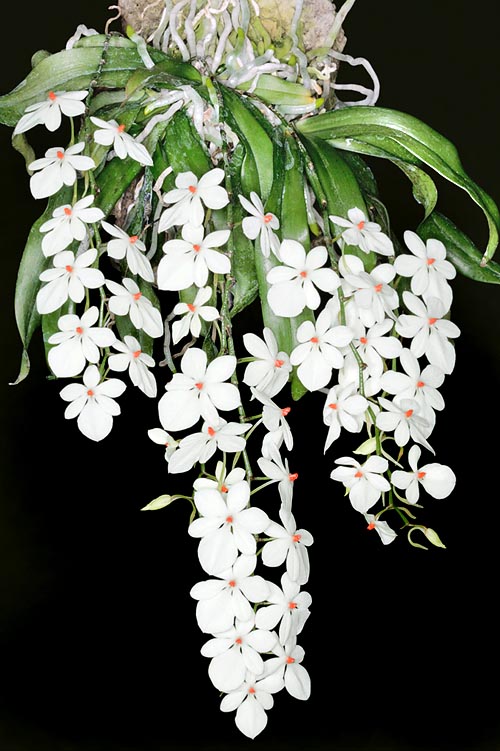Family : Orchidaceae

Text © Pietro Puccio

English translation by Mario Beltramini

The small Aerangis luteoalba var. rhodosticta has 30 cm inflorescences © G. Mazza
This species is native to tropical Africa (Cameroon, Democratic Republic of Congo, Ethiopia, Kenya, Tanzania and Uganda), where it lives, epiphytic, usually on shrubs, in the humid forests, between 700 and 1800 m of altitude, close to water streams.
The name of the genus is the combination of the Greek terms “aer” = air and “angos” = urn, with probable reference to the spur; the name of the species is the combination of the Latin terms “luteus, a, um” = yellow and “albus, a, um” = white; the name of the variety is the combination of the Greek terms “rodon” = pink and “stictos” = spotted, with reference to the orange of bright red column standing out at the centre of the flower.
The Aerangis luteoalba var. rhodosticta (Kraenzl.) J. Stewart (1979) is a monopodial epyphite with roots often flat which adhere to the bark of the branches.
The leaves, almost distichous, are fleshy, curved, of pale green colour, 4-14 cm long and up to 2 cm broad, with bilobate apex.
It has curved or drooping racemose inflorescences, up to about 30 cm long, carrying 6-25 flat flowers, of 2-4 cm of diameter, with curved spur, up to about 4 cm long, at the base of the labellum.
The flowers are placed on two rows lying almost on the same level, with white to cream white sepals and petals on which stands out, at the centre, the column, rather small, orange or bright red.
One of the most ornamental miniature orchids, with long-lasting, 4-6 weeks, flowers, it requires a shaded position, high daytime temperatures (24-28 °C), with high daily temperature range, ideal of 10-12 °C, and humidity, 70-90%, during the vegetative period in spring-summer, cooler conditions (4-5 °C less) and dry (around the 60%) in winter during the rest; a good air movement is important.
It prefers to stay on a cork raft or on branches, possibly with some sphagnum at the base; it can be cultivated also in pot with medium-sized bark, or other draining material, but the risk of stagnating humidity is bigger with consequent radical rottenness.
Rainwater, or water obtained by reverse osmosys or demineralized is to be used for the waterings and the nebulisations. It is quite sensitive to the damage of the roots and therefore a particular care is to be taken in the repotting or in the positioning on bark. The fertilizations, appropriately distributed in way to avoid accumulation of salts, are to be done preferably with balanced water-soluble products, with micro-elements, at half dosage, or less, of what suggested on the package. The species is inserted into the appendix II of CITES (species whose trade is ruled at an international level.
Synonyms: Angraecum rhodostictum Kraenzl. (1896); Angorchis rhodosticta (Kraenzl.) Kuntze (1903); Angraecum albidorubrum De Wild. (1916); Aerangis albidorubra (De Wild.) Schltr. (1918); Aerangis rhodosticta (Kraenzl.) Schltr. (1918); Angraecum mirabile auct. (1923).
→ For general notions about ORCHIDACEAE please click here.
